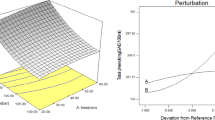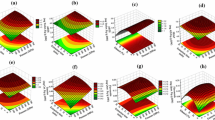Abstract
Pomegranate peels are very rich in bioactive compounds, particularly antioxidants, that when properly extracted, may be used for different applications such as food, cosmetics, and pharmaceutics. In this paper, we studied the effect of high-pressure extraction on antioxidant activity and bioactive compounds (total phenolics, tannins, flavonoids, and anthocyanins) of pomegranate peel, using a Box–Behnken design to evaluate the effects of pressure, extraction time, and ethanol concentration to estimate the optimum extraction conditions by response surface methodology (RSM). Individual phenolics, tannins, and anthocyanins were also identified and quantified using the optimum extraction conditions identified by RSM. The results indicated that a quadratic polynomial model could be used to optimize high-pressure extraction of bioactive compounds from pomegranate peel (R 2 higher than 0.90). Ethanol concentration was the variable with higher impact and high pressure increased in average 13% the extraction amount of bioactive compounds. The optimum extraction conditions were similar for all compounds (except for anthocyanins) ranging between 356 and 600 MPa, 32 and 56% of ethanol, and 30 min of extraction time. A pressure of 492 MPa, extraction time of 30 min, and an ethanol concentration of 37% were found to result in the highest amount of the quantified individual compounds. Analysis of variance indicated a high goodness of fit of the used models and adequacy of response surface methodology for optimizing high-pressure extraction. The pomegranate peels are industrial by-products that are rich in bioactive compounds and the results obtained in this work show that high pressure is a promising process for scale up of extraction processes. However, pilot plant tests at higher scale will be necessary to ponder the economic viability of the process.


Similar content being viewed by others
References
Almeida, M. M. B., Sousa, P. H. M., Arriaga, A. M. C., Prado, G. M., Magalhães, C. E. C., Maia, G. A., et al. (2011). Bioactive compounds and antioxidant activity of fresh exotic fruits from northeastern Brazil. Food Research International, 44(7), 2155–2159.
Al-Rawahi, A. S., Edwards, G., Al-Sibani, M., Al-Thani, G., Al-Harrasi, A. S., & Rahman, M. S. (2014). Phenolic constituents of pomegranate peels (Punica granatum L.) cultivated in Oman. European Journal of Medicinal Plants, 4(3), 315–331.
Awika, J. M., Rooney, L. W., Wu, X., Prior, R. L., & Cisneros-Zevallos, L. (2003). Screening methods to measure antioxidant activity of sorghum (Sorghum bicolor) and sorghum products. Journal of Agricultural and Food Chemistry, 51(23), 6657–6662.
Benzie, I. F. F., & Strain, J. J. (1996). The ferric reducing ability of plasma (FRAP) as a measure of antioxidant power: the FRAP assay. Analytical Biochemistry, 239(1), 70–76.
Bobo-García, G., Davidov-Pardo, G., Arroqui, C., Vírseda, P., Marín-Arroyo, M. R., & Navarro, M. (2014). Intra-laboratory validation of microplate methods for total phenolic content and antioxidant activity on polyphenolic extracts, and comparison with conventional spectrophotometric methods. Journal of the Science of Food and Agriculture, 95(1), 204–209.
Bolanos de la Torre, A. A. S., Henderson, T., Nigam, P. S., & Owusu-Apenten, R. K. (2015). A universally calibrated microplate ferric reducing antioxidant power (FRAP) assay for foods and applications to Manuka honey. Food Chemistry, 174, 119–123.
Cardador-Martínez, A., Jiménez-Martínez, C., & Sandoval, G. (2011). Revalorization of cactus pear (Opuntia spp.) wastes as a source of antioxidants. Food Science and Technology (Campinas), 31, 782–788.
Cardoso, L. C., Serrano, C. M., Quintero, E. T., López, C. P., Antezana, R. M., & Martínez de la Ossa, E. (2013). High pressure extraction of antioxidants from Solanum stenotomun peel. Molecules, 18(3), 3137–3151.
Corrales, M., Toepfl, S., Butz, P., Knorr, D., & Tauscher, B. (2008). Extraction of anthocyanins from grape by-products assisted by ultrasonics, high hydrostatic pressure or pulsed electric fields: a comparison. Innovative Food Science & Emerging Technologies, 9(1), 85–91.
Corrales, M., García, A. F., Butz, P., & Tauscher, B. (2009). Extraction of anthocyanins from grape skins assisted by high hydrostatic pressure. Journal of Food Engineering, 90(4), 415–421.
Cruz, L. C., Batista, J. E. S., Zemolin, A. P. P., Nunes, M. E. M., Lippert, D. B., Royes, L. F. F., et al. (2014). A study on the quality and identity of Brazilian pampa biome honey: evidences for its beneficial effects against oxidative stress and hyperglycemia. International Journal of Food Science, 2014, 1–11.
Fernandes, I., Marques, F., de Freitas, V., & Mateus, N. (2013). Antioxidant and antiproliferative properties of methylated metabolites of anthocyanins. Food Chemistry, 141, 2923–2933.
Fischer, U. A., Carle, R., & Kammerer, D. R. (2011). Identification and quantification of phenolic compounds from pomegranate (Punica granatum L.) peel, mesocarp, aril and differently produced juices by HPLC-DAD–ESI/MSn. Food Chemistry, 127, 807–821.
Grunovaitė, L., Pukalskienė, M., Pukalskas, A., & Venskutonis, P. R. (2016). Fractionation of black chokeberry pomace into functional ingredients using high pressure extraction methods and evaluation of their antioxidant capacity and chemical composition. Journal of Functional Foods, 24, 85–96.
Guan, D. & Hoover, D.G. (2005). Emerging decontamination techniques for meat: improving the safety of fresh meat. J. N. Sofos (eds). Woodhead Publishing Limited, Boca Raton, USA, 388–417.
Huang, H. W., Hsu, C. P., Yang, B. B., & Wang, C. Y. (2013). Advances in the extraction of natural ingredients by high pressure extraction technology. Trends in Food Science & Technology, 33(1), 54–62.
Lee, J., Durst, R. W., & Wrolstad, R. E. (2005). Determination of total monomeric anthocyanin pigment content of fruit juices, beverages, natural colorants, and wines by the pH differential method: collaborative study. Journal of AOAC International, 88(5), 1269–1278.
Leong, L. P., & Shui, G. (2002). An investigation of antioxidant capacity of fruits in Singapore markets. Food Chemistry, 76(1), 69–75.
Liyana-Pathirana, C., & Shahidi, F. (2005). Optimization of extraction of phenolic compounds from wheat using response surface methodology. Food Chemistry, 93(1), 47–56.
Naczk, M., Amarowicz, R., Pink, D., & Shahidi, F. (2000). Insoluble condensed tannins of canola/rapeseed. Journal of Agricultural and Food Chemistry, 48(5), 1758–1762.
Nilsson, J., Pillai, D., Onning, G., Persson, C., Nilsson, A., & Akesson, B. (2005). Comparison of the 2,2-azinobis-3-ethylbenzotiazo-line-6-sulfonic acid (ABTS) and ferric reducing anti-oxidant power (FRAP) methods to assess the total antioxidant capacity in extracts of fruit and vegetables. Molecular Nutrition & Food Research, 49(3), 239–246.
Oey, I., Lille, M., Van Loey, A., & Hendrickx, M. (2008). Effect of high pressure processing on colour, texture and flavour of fruit- and vegetable-based food products: a review. Trends in Food Science & Technology, 19(6), 320–328.
Pantelidis, G. E., Vasilakakis, M., Manganaris, G. A., & Diamantidis, G. (2007). Antioxidant capacity, phenol, anthocyanin and ascorbic acid contents in raspberries, blackberries, red currants, gooseberries and cornelian cherries. Food Chemistry, 102(3), 777–783.
Prasad, K. N., Yang, E., Yi, C., Zhao, M., & Jiang, Y. (2009a). Effects of high pressure extraction on the extraction yield, total phenolic content and antioxidant activity of longan fruit pericarp. Innovative Food Science & Emerging Technologies, 10(2), 155–159.
Prasad, K. N., Yang, B. A. O., Zhao, M., Ruenroengklin, N., & Jiang, Y. (2009b). Application of ultrasonication or high pressure extraction of flavonoids from litchi fruit pericarp. Journal of Food Process Engineering, 32(6), 828–843.
Prasad, K. N., Yang, B., Shi, J., Yu, C. Y., Zhao, M. M., Xue, S., et al. (2010). Enhanced antioxidant and antityrosinase activities of longan fruit pericarp by ultra-high pressure-assisted extraction. Journal of Pharmaceutical and Biomedical Analysis, 51(2), 471–477.
Rombaut, N., Tixier, A. S., Bily, A., & Chemat, F. (2014). Green extraction processes of natural products as tools for biorefinery. Biofuels, Bioproducts and Biorefining, 8, 530–544.
Saad, H., Charrier-El Bouhtoury, F., Pizzi, A., Rode, K., Charrier, B., & Ayed, N. (2012). Characterization of pomegranate peels tannin extractives. Industrial Crops and Products, 40, 239–246.
Santos, M. C., Salvador, Â. C., Domingues, F. M., Cruz, J. M., & Saraiva, J. A. (2013). Use of high hydrostatic pressure to increase the content of Xanthohumol in beer Wort. Food Bioprocess Technology, 6(9), 2478–2485.
Shen, J., Gou, Q., Zhang, Z., & Wang, M. (2016). Effects of high hydrostatic pressure on the quality and shelf-life of jujube (Ziziphus jujuba mill.) pulp. Innovative Food Science & Emerging Technologies, 36, 166–172.
Shouqin, Z., Jun, X., & Changzheng, W. (2005). High hydrostatic pressure extraction of flavonoids from propolis. Journal of Chemical Technology & Biotechnology, 80(1), 50–54.
Singleton, V. L., Orthofer, R., & Lamuela-Raventós, R. M. (1999). Analysis of total phenols and other oxidation substrates and antioxidants by means of folin-ciocalteu reagent. Methods in Enzymology, 299, 152–178.
Thaiponga, K., Boonprakoba, U., Crosbyb, K., Cisneros-Zevallos, L., & Byrne, D. H. (2006). Comparison of ABTS, DPPH, FRAP, and ORAC assays for estimating antioxidant activity from guava fruit extracts. Journal of Food Composition and Analysis, 19, 669–675.
**, J. (2006). Effect of high pressure processing on the extraction of lycopene in tomato paste waste. Chemical Engineering & Technology, 29, 736–739.
Zaouay, F., Mena, P., Garcia-Viguera, C., & Mars, M. (2012). Antioxidant activity and physico-chemical properties of Tunisian grown pomegranate (Punica granatum L.) cultivars. Industrial Crops and Products, 40, 81–89.
Zhang, S., Bi, H., & Liu, C. (2007). Extraction of bio-active components from Rhodiola sachalinensis under ultrahigh hydrostatic pressure. Separation and Purification Technology, 57(2), 277–282.
Zhu, C., & Liu, X. (2013). Optimization of extraction process of crude polysaccharides from pomegranate peel by response surface methodology. Carbohydrate Polymers, 92(2), 1197–1202.
Acknowledgments
This work was supported by National Funds from FCT–Fundação para a Ciência e a Tecnologia through project UID/Multi/50016/2013 and by FCT/MEC by the financial support to the QOPNA research Unit (FCT UID/QUI/00062/2013), through national funds and where applicable co-financed by the FEDER, within the PT2020 Partnership Agreement. Author Elisabete Maria Cruz Alexandre also is grateful for the financial support of this work from “Fundação para a Ciência e Tecnologia - FCT” through the Post-doctoral Grant SFRH/BPD/95795/2013.
Author information
Authors and Affiliations
Corresponding author
Rights and permissions
About this article
Cite this article
Alexandre, E.M., Araújo, P., Duarte, M.F. et al. Experimental Design, Modeling, and Optimization of High-Pressure-Assisted Extraction of Bioactive Compounds from Pomegranate Peel. Food Bioprocess Technol 10, 886–900 (2017). https://doi.org/10.1007/s11947-017-1867-6
Received:
Accepted:
Published:
Issue Date:
DOI: https://doi.org/10.1007/s11947-017-1867-6




